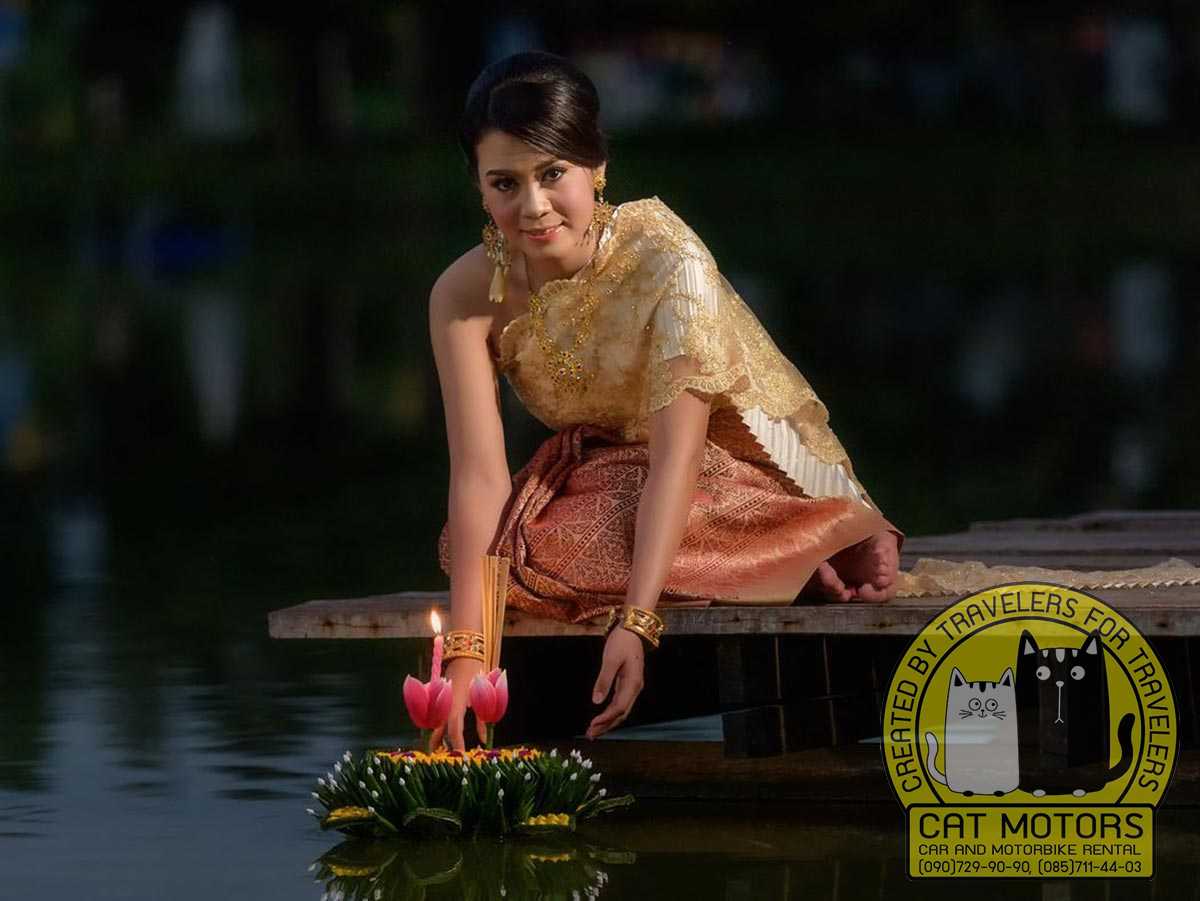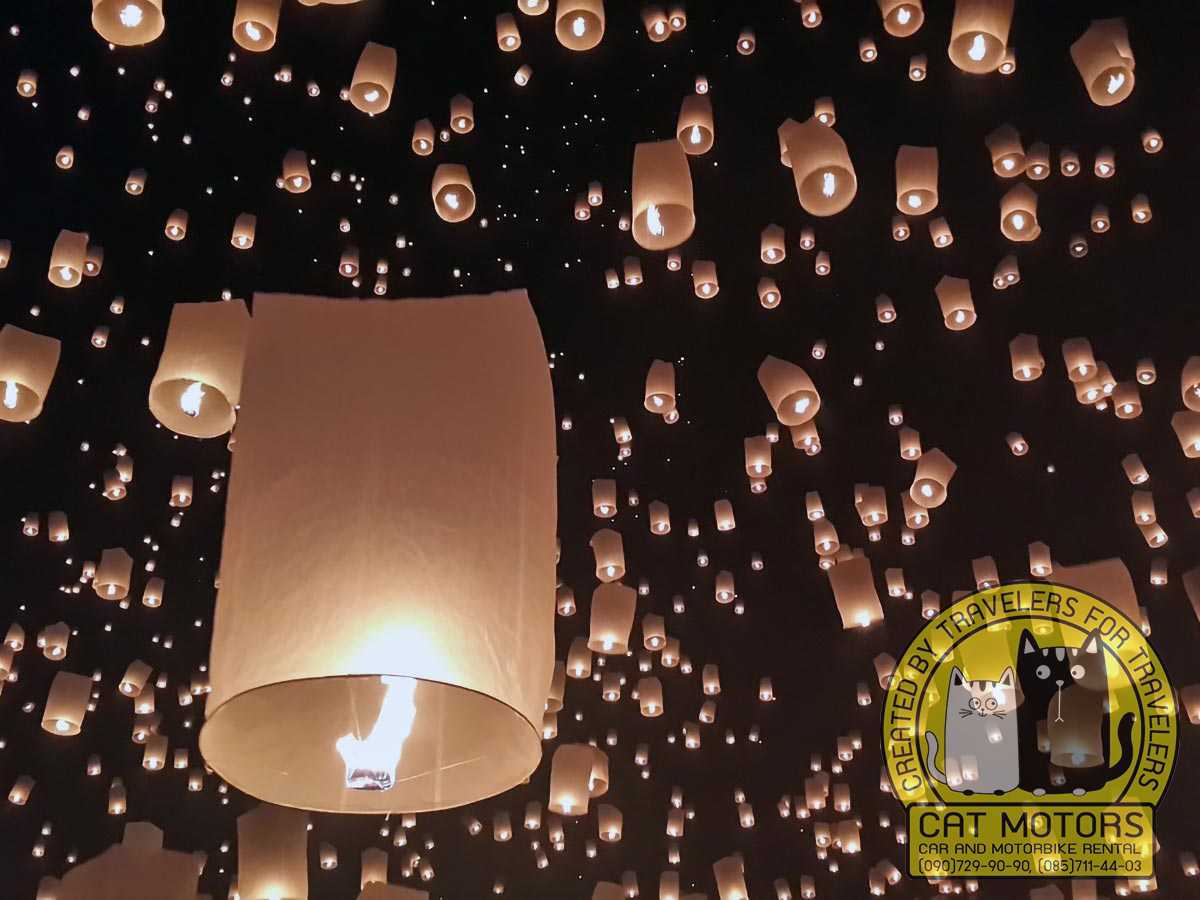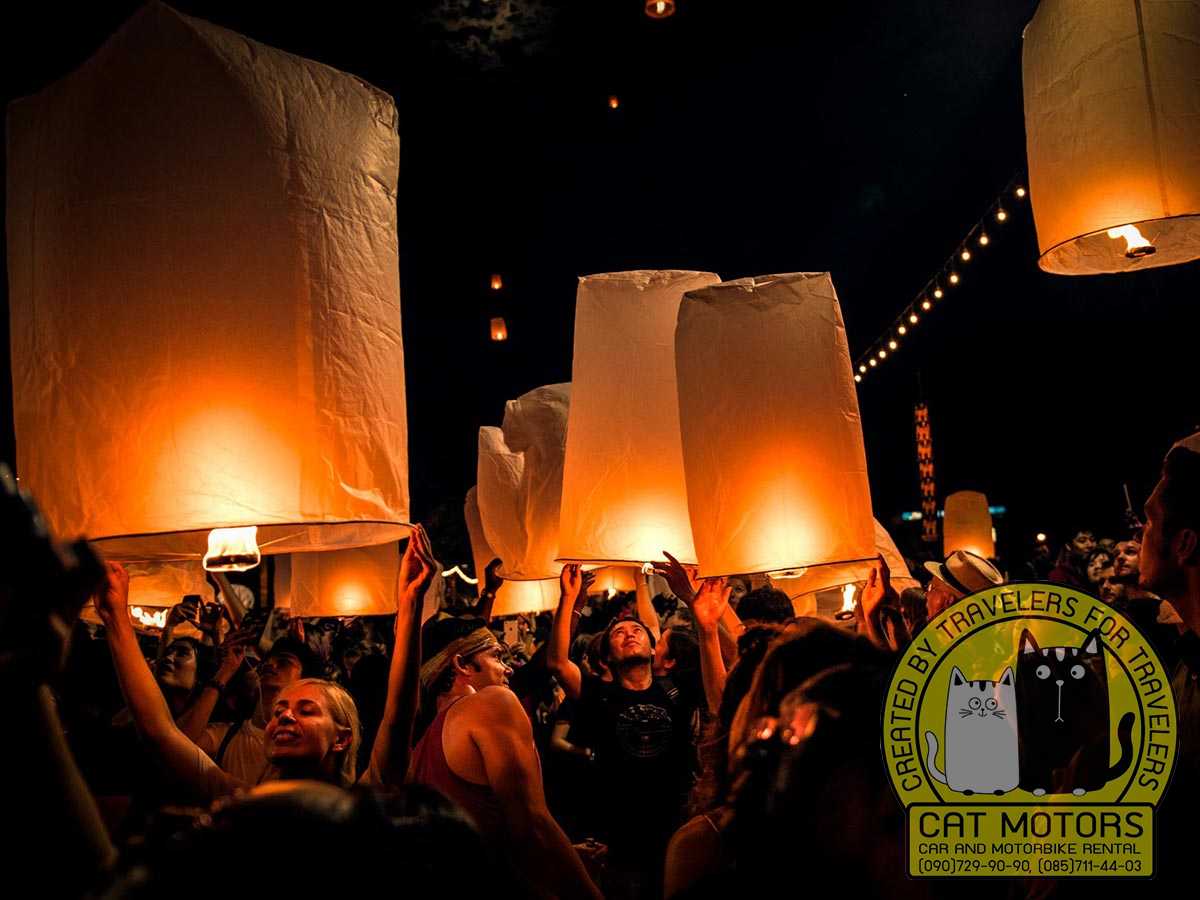Loy Krathong: Chiang Mai's Spectacular Festival You Can't Miss
The Loy Krathong festival in Chiang Mai is a mesmerizing celebration of lights and water. This festival attracts locals and tourists from around the world. When visiting the Loy Krathong festival in Chiang Mai, Thailand, you will experience Thai traditions that exhibit stunning light displays and cultural heritage.
Here we will learn more about the enchanting Loy Krathong festival, plus the simultaneous Yi Peng Lantern festival held in Chiang Mai. It is possibly the best place in Thailand to experience the two festivals. Read on to learn more about the captivating history, ceremonial rituals, cultural significance, and what you can anticipate when experiencing these festivals.
Loy Krathong: A Cultural Extravaganza
Loy Krathong is a captivating and vibrant festival celebrated throughout Thailand and nearby countries strongly influenced by South-Western Thai culture (e.g., Laos). However, the event is particularly spectacular in Chiang Mai. Here, the festival is a cherished tradition that combines ancient customs, spiritual beliefs, and a sense of communal unity. But what is it all about?
Historical Origins
The Loy Krathong Festival is also called the Festival of Lights. In Thai, the word “Loy” means “to float,” while a “Krathong” is a lotus-shaped boat made from banana leaves and bark. So, Loy Krathong actually means to float a lotus-shaped boat. Nowadays, krathongs are made from other materials, such as bread or Styrofoam.

The festival originated in India. However, in Thai culture and folklore, it is said to have originated during the Sukhothai period in the year 800. A popular story says King Ram Khamhaeng of Sukhothai took an extravagant river cruise to celebrate the full moon of the twelfth lunar month. Here, the king’s favorite mistress, Nang Nophamas (or Nopphamat), created the first-ever krathong.
Nang Nophamas put flowers, a lit candle, and incense sticks in the center of the krathong. She then released it onto the river to honor Buddha and the Thai Water Goddess, Mae Phra Khongkha. Mae Phra Khongka is also referred to as the Hindu Goddess Ganga.
Cultural Significance
Loy Krathong is the second most significant festival in Thailand, after Songkran. It’s an occasion for friends and family to spend together and make merit.
Amongst many other thoughts, it is believed that if a couple releases separate krathongs that float together, they will see how long their relationship will last in this life or the next. As such, many couples join their krathongs with string to keep them floating together.
However, there are many reasons for the symbolic release of a krathong. They include the following:
- To honor Buddha,
- To honor and thank the Thai Water Goddess for life-giving water,
- To express gratitude for the year’s bountiful harvests,
- To seek forgiveness for polluting the waterways and any other wrongdoings committed,
- To see how long you and your loved one will be together,
- To let go of negativity and misfortunes, and
- To make a wish for a prosperous future.
Loy Krathong is seen as a time of renewal, both individually and collectively, and an opportunity to seek forgiveness and make amends. The festival is often associated with the concept of “sanuk,” which means to have fun and enjoy life. Here, people come together, celebrate their shared cultural heritage, and foster a sense of unity and harmony.
This festival also showcases the unique Lanna (also called Lan Na) culture deeply rooted in the region. Lanna refers to the historical Kingdom of Lanna, which encompassed parts of present-day Northern Thailand, Myanmar, and Laos.
Thus, Loy Krathong allows one to explore Lanna’s art forms, traditional music, and dance and witness ancient rituals passed down through generations.
When Does The Loy Krathong Festival Take Place?
The Loy Krathong festival takes place every year on the twelfth lunar month’s full moon. This means it usually falls in November, at the end of the monsoon season.
Preparations and Festive Atmosphere
Preparations for the Loy Krathong Festival begin weeks in advance, especially in Chiang Mai. This is because the Yi Peng Festival requires much preparation too – but more on that soon.
Locals meticulously prepare elaborate krathongs in advance, testing the designs of their floating decorations. Additionally, Chiang Mai is decorated with flowers and adorned with countless lanterns and lights, creating a magical atmosphere that builds anticipation.
In addition to floating krathongs and releasing lanterns, Loy Krathong in Chiang Mai offers various other activities. For example, beauty contests and fireworks displays have become popular activities. Also, traditional Thai games, such as takraw (a form of volleyball played with the feet), are played in the streets.
At the same time, local day and night markets offer delectable street food and handicrafts. Visitors can immerse themselves in the cultural traditions by donning traditional Thai attire, receiving blessings from monks, or participating in temple ceremonies.
Ceremonial Rituals
Throughout Thailand, on the evening of the Loy Krathong Festival, locals and visitors gather alongside bodies of water. They eagerly await the moment to release their floating lanterns into the Ping River, canals, lakes, or reservoirs. However, in Chiang Mai, the Loy Krathong celebrations extend beyond the riverbanks.
The city’s ancient moat, which surrounds the historic Old City, becomes a focal point for the festival. The streets in Old City are filled with a carnival-like atmosphere, including elaborate parades, cultural performances, traditional music, and dancing.
The ceremony commences with the Yin Peng Parade featuring elaborate floats, drums, traditional music, and dancers dressed in colorful Thai costumes. Next, dancers perform traditional dances, such as Ram Wong and Fon Lep, showcasing their region’s heritage.
Then, as the full moon ascends in the night sky, participants light candles and incense sticks on their krathongs. Before gently releasing the krathongs, the participants make a wish. The flickering lights drifting away represent the previous year’s misfortunes being carried away, offering new beginnings.
As you can well imagine, the sight of flickering lights on the water and the serene surroundings is breathtaking. However, the Yi Peng Lantern Festival adds even more magic to this special time.
Yi Peng Lantern Festival
While Loy Krathong Festival is marked by lights floating on water, the Yi Peng Lantern Festival (also called Yee Peng Festival) is characterized by the mass release of thousands of sky lanterns (called yi peng or khom loi) into the dusky sky. The flickering lights against the backdrop of the full moon are a beautiful and awe-inspiring sight to behold, especially in the ancient Lanna capital, Chiang Mai.

Yi peng lanterns are crafted from thin fabric stretched over a bamboo frame. A candle or small fuel cell is suspended in the center of the lantern. When lit, the warm air inside the delicate lanterns causes them to lift skyward, symbolizing the release of trouble and worries.
Additionally, participants in this festival write their wishes and aspirations on their lanterns before lighting them and watching them climb gently toward the heavens. They believe that as the lanterns ascend, they carry away their prayers and aspirations, bringing good luck and blessings for the year ahead.
Again, the sight of thousands of glowing lanterns drifting upward in the night sky is magical to behold. However, you will only get to enjoy the Yi Peng Festival in Chiang Mai and other parts of Northern Thailand, making this time of year extra special for locals and visitors.
When Does Yi Peng Festival Take Place?
As mentioned, Yi Peng Festival coincides with the Loy Krathong Festival in Chiang Mai. “Yi” means “two,” and “peng” means “full moon day.” Thus, Yi Peng refers to the full moon day of the second month of the Lanna lunar calendar. Additionally, the second month of the Lanna lunar calendar coincides with the twelfth month of the Thai lunar calendar.
Environmental Impact of Loy Krathong and Yi Peng Festivals
As beautiful as the festival is to behold, concerns prevail about the environmental impact of the mass lantern releases. For example, using non-biodegradable materials in krathongs, lanterns, and fireworks has led to the pollution of rivers and water bodies, harming the environment and making the water unsafe for consumption.
The thousands of lanterns pose a problem to aircraft navigating around Chiang Mai and other large Thai cities. For example, after the Yi Peng Festival in 2017, the Chiang Mai Airport had to cancel 78 flights and reschedule 79 flights because of the risk the lanterns posed. Additionally, lanterns that had fallen on the airport grounds threatened planes landing and taking off.

Therefore, efforts are being made to promote eco-friendly alternatives. For instance, some krathongs are made with bread or natural plant materials. However, the bread will disintegrate after a few days, giving food to the fish. Therefore, Styrofoam krathongs are strongly discouraged.
In centers like Bangkok, the public may not release lanterns or fireworks at all. If they do, they could face three years of imprisonment. Therefore, people who release lanterns in Chiang Mai are encouraged to make or use smaller lanterns of readily biodegradable materials, e.g., paper and bamboo, instead of fabric and plastic.
Travelers' Tips
As a tourist in Chiang Mai during Loy Krathong and Yee Peng, it is essential to note that the city will be busier than usual. Therefore, consider the following tips if you plan to visit during the Loy Krathong Festival:
- The roads and traffic will be bustling. Be patient when riding a scooter or car, noting that some roads will be closed to traffic in preparation for the parade. There will also be a lot more pedestrians than usual.
- Catching a red truck, bus, or tuk-tuk might take longer than usual, so schedule accordingly.
- Finding accommodation might be more challenging, so book further in advance if you plan to visit Chiang Mai during these festivals.
- Ensure you keep your belongings safe in a backpack or bag that you can sling across your body. Even though crime is petty, there are pickpockets in the area. So don’t keep your phone, money, or keys in your back pockets.
- Respect local authorities and adhere to policies on dress codes or admission requirements in certain areas. For example, you might need to purchase tickets to enjoy some shows.
- The launch of lanterns on a windy evening is not advisable. They can result in fires breaking out among the crowds.
- Thai culture believes that wearing black signifies bad luck and invites evil spirits. Thus, it might be better for tourists to avoid wearing black, especially during festivals. The only appropriate time to wear this symbolic color is at funerals.
Quick Facts
1. Origins: Loy Krathong is believed to have originated during the Sukhothai period around the year 800, in present-day Thailand.
2. Meaning: “Loy” means “to float,” and a “Krathong” is a lotus-shaped boat made from banana leaves. Thus, Loy Krathong means “to float a lotus-shaped boat”.
3. Festival of Lights: The festival is also known as the Festival of Lights due to the countless flickering lights from the krathongs that are floated on the water bodies.
4. Date: It takes place on the full moon of the twelfth lunar month, usually in November, marking the end of the monsoon season.
5. Cultural Significance: It is the second most significant festival in Thailand, after Songkran. Loy Krathong is seen as a time of renewal, both individually and collectively.
6. Ritual: People float krathongs on bodies of water to pay respects to the Buddha and the Thai Water Goddess, Mae Phra Khongkha, and to seek forgiveness for any wrongdoings, particularly those against water and nature.
7. Yi Peng Festival: In Chiang Mai, Loy Krathong coincides with the Yi Peng festival, where thousands of lanterns are released into the sky, creating an awe-inspiring spectacle.
8. Communal Unity: The festival is a cherished tradition that combines ancient customs, spiritual beliefs, and a sense of communal unity.
9. Lanna Culture: In Chiang Mai, the festival also showcases the unique Lanna (Lan Na) culture of the region, offering a glimpse into traditional music, art, and dance forms.
10. Festive Atmosphere: The streets of Chiang Mai transform into a carnival-like atmosphere with parades, cultural performances, traditional music, and dancing, making it the best place to experience the Loy Krathong festival.
Our Summary
The Loy Krathong festival in Chiang Mai is a magical and captivating celebration that combines ancient traditions, spiritual beliefs, and a rich cultural experience. The festival’s origins in the ancient kingdom of Sukhothai and its evolution in Chiang Mai have created a unique event that draws visitors from around the world.
The floating of krathongs and the release of lanterns symbolize letting go of the past, seeking forgiveness, and making wishes for the future. The festival’s ambiance, with its parades, cultural performances, and bustling markets, creates an atmosphere of joy and unity.
FAQ
The Loy Krathong Festival is believed to have originated during the Sukhothai period around the year 800 in present-day Thailand. There’s a popular story involving King Ramakhamhaeng’s mistress, Nang Nophamas, creating the first-ever krathong.
In Thai, “Loy” means “to float,” while a “Krathong” is a lotus-shaped boat made traditionally from banana leaves and bark. Thus, “Loy Krathong” essentially translates to “floating a lotus-shaped boat.”
The festival is known as the Festival of Lights because of the countless flickering lights from the krathongs that are floated on water bodies. The spectacle of these lights on the water during the evening of the festival is truly mesmerizing.
Loy Krathong takes place on the full moon of the twelfth lunar month, typically falling in November. The festival marks the end of the monsoon season.
Loy Krathong is the second most significant festival in Thailand, after Songkran. It’s seen as a time of renewal, allowing individuals and communities to seek forgiveness and let go of negativity. The festival fosters a sense of communal unity and celebration.
During the festival, people light candles and incense sticks on their krathongs and float them on bodies of water to pay respects to Buddha and the Thai Water Goddess, Mae Phra Khongkha. The floating krathongs are also seen as a way to seek forgiveness for any wrongdoings against water and nature.
In Chiang Mai, Loy Krathong coincides with the Yi Peng festival, a Lanna tradition. While krathongs are floated on water during Loy Krathong, Yi Peng involves the release of thousands of lanterns into the sky, creating an awe-inspiring spectacle.
Loy Krathong is a cherished tradition that combines ancient customs and spiritual beliefs, fostering a sense of communal unity. The event is a moment when people come together, let go of past grievances, and celebrate their shared cultural heritage.
Chiang Mai was once the capital of the Lanna Kingdom, and Loy Krathong here showcases the region’s unique culture. It offers a glimpse into traditional music, art forms, and dance. The simultaneous Yi Peng festival is also a Lanna tradition that adds to this cultural display.
During the Loy Krathong festival, Chiang Mai transforms into a carnival-like atmosphere. The city is adorned with countless lanterns and flowers. Streets are filled with parades, cultural performances, traditional music, and dancing, making it an incredibly vibrant and festive place to be.
Traditionally, the krathong is a lotus-shaped boat made from banana leaves and bark. Today, they can also be made from other materials such as bread or Styrofoam. The krathong usually carries flowers, a lit candle, and incense sticks.
There are many beliefs associated with floating a krathong. It is said that if a couple’s krathongs float together, it’s a sign of how long their relationship will last. Additionally, as the krathongs carry away the light, they’re believed to take with them the previous year’s misfortunes, symbolizing a fresh start.
Explore Northern Thailand’s majestic landscapes and vibrant culture with our comprehensive travel guides. They provide detailed routes and highlight key attractions. Begin your journey by checking our scooter hire in Chiang Mai homepage for the best rental options. Don’t forget to review our rental terms to ensure a hassle-free experience. These resources will prepare you to navigate through Northern Thailand’s scenic paths and cultural hotspots with ease.
In addition, our website offers valuable tips on safe riding, the best times to travel, and how to engage with local customs. This information will help you make informed decisions throughout your journey, enhancing your travel experience and ensuring your safety.
Was this post useful for you?
You can rate it by clicking on a star
Average rating / 5. Vote count:
No votes so far! Be the first to rate this post.
We are sorry that this post was not useful for you!
Let us improve this post!
Tell us how we can improve this post?
- Author: Krit Sorenser
- Updated: 26/03/2025
- No Comments




